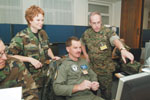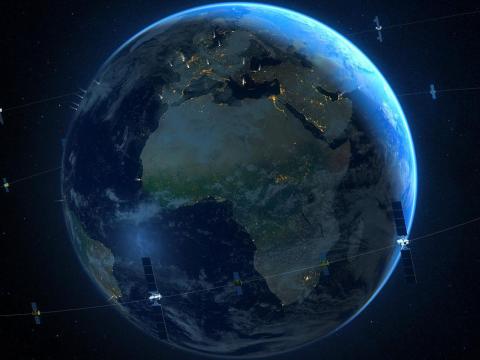New Venue, New Focus
 |
| At the U.S. European Command (EUCOM) in Stuttgart, Germany, Col. Tim Cassidy, USMCR (r), coalition task force commander, Coalition Warrior Interoperability Demonstration (CWID) 2006, points out key changes to the common operating picture to 1st Lt. Chani Devers, Air National Guard, and Wing Commander Rodger Pringle, RNZAF. EUCOM was the host combatant command for this year’s event. |
This year’s Coalition Warrior Interoperability Demonstration was just as much about evaluating the event itself as it was about evaluating technologies. Although the 2006 format mirrored previous years’ activities, the lessons learned during the first time the execution phase was hosted outside the
The U.S. European Command (EUCOM),
The script involved notional countries facing imaginary conflicts and placed CWID participants in different phases of operations. For the CTF section, the western continental
For the homeland security and homeland defense scenario, terrorists launch attacks in the
Technologies proposed for testing during the execution phase of CWID had to address at least one of five objectives: coalition command and control, coalition information sharing, integrated logistics, continuity of operations and network-centric enterprise services. Among the capabilities CWID participants examined were information and mission management systems, emergency response communications and information sharing technologies, information security techniques and collaboration software.
Many of the nations that have participated in previous demonstrations returned for this year’s event.
This is the second year that the U.S. Joint Forces Command (JFCOM),
JFCOM also helps coordinate and develop the required data to support post-execution transition decisions. Working with the host combatant commander, the Joint Chiefs of Staff and leaders of the senior management group—the team that organizes the demonstration—JFCOM will determine the appropriate process and program to deliver chosen capabilities to warfighters.
But JFCOM is not the only organization outside of the COCOMs that supports the demonstrations. Since 2003, the Defense Information Systems Agency (DISA),
Steve Ewell, deputy director, international interoperability, concepts and experimentation, J-9, EUCOM, says CWID is “incredibly important” to the command and his involvement in this year’s event convinced him that it can play a crucial role in expanding international interoperability. He adds that EUCOM supports any venue the United States offers that promotes international interoperability—including CWID—even in today’s environment of shrinking budgets. And as the number of multinational operations increases, the need for numerous nations’ systems to communicate with each other grows. Ewell notes that the total number of foreign troops deployed to
In addition to participation from the five-eye partners and selected NATO allies, this year’s event allowed the command to work with participants from
Ewell believes that while progress is being made to address international interoperability challenges in this subset of countries, it is important for the
Although Ewell says the CWID 2006 execution phase was an unequivocal success, he admits that the challenge now and throughout the year will be to find a way to transition the trial technologies that show promise into funded solutions. EUCOM participants believes that this objective can be achieved by modifying several aspects of the event.
At the top of the list, Ewell emphasizes, is increasing the number of countries that are allowed to participate in future CWIDs. The crosstalk within the
The command’s second recommendation is to link CWID directly with the Office of the Undersecretary of Defense for Acquisition, Technology and Logistics (AT&L) advanced systems and concepts by inviting representatives to participate as permanent members of the CWID senior management group. This change would offer increased visibility into some industry efforts and the armed services’ battle laboratories, Ewell points out.
“If you really look at this, you have CWID going to the host COCOM to ask, ‘What are your capability shortfalls?’ We quantify those in the objectives, and we send those around to the other COCOMs. We receive their buy-in and that information goes out as a federal business offering. New technology is brought in, and in a perfect world, the new technologies that are demonstrated transition to a funded program and give us an increased capability either in government agencies or on the battlefield,” he says. Ewell explains that the AT&L’s advanced concept technology demonstration and joint capabilities technology demonstration programs are similar to CWID. “It sure would be nice if we got people together and started coordinating activities,” he states. Representatives from EUCOM and the Joint Chiefs of Staff met in mid-July to discuss the issue, Ewell adds.
EUCOM’s third recommendation involves increasing the coordination between the
“The final point that was a constant stumbling block through this is that in order to improve CWID, if it’s really going to be an international interoperability forum, the participating countries have to come to grips with information and technology sharing policies. They all have to agree that they’re going to have to accept a bit of risk for interoperability. What I’ve observed over the last year as I watched the organizational phase of CWID and helped put this together at EUCOM is that governments tend to be multidomestic and not multinational,” he relates.
 |
| Col. Cassidy (l) briefs CWID visitors (2nd l-r) Brig. Gen. Dennis Via, USA; Command Sgt. Maj. Rodrick Johnson, USA; and Dr. Judith Daly about the demonstration’s operations at EUCOM. |
Although he is not sure of the solution to this problem, Ewell notes that NATO is addressing the issue with a long-term program that includes a 15-year plan to move to network-centric warfare. The organization’s members accept that in the interim they will have to interface with countries that do not have the same technology base. In many cases, this will require tuning down the level of their own capabilities to facilitate interoperability.
Despite the benefits this approach, it also has some drawbacks. The United States would have to determine the balance between increasing warfighting capabilities—which will be important if the U.S. military plans to undertake operations alone—and ensuring international interoperability if it decides to form coalitions to achieve its policy goals. “So there is truly a trade-off, but if we’re going to work toward international interoperability, it’s something that needs to be addressed,” Ewell contends.
The only other solution he envisions is for the
Ewell says he was very impressed with a number of the capabilities examined during CWID at the EUCOM site, but reiterates that the challenge to move even the most promising technologies into the field must be addressed. He suggests one way to overcome the problem may be a technique the command employs. Before examining prototype technologies at EUCOM, Ewell finds a sponsor for the capability. He calls this an “acquisition technology transition strategy.”
Bringing AT&L and JFCOM in to identify some of the most promising technologies early in the CWID planning process would provide the time needed to outline a transition strategy in advance of the demonstration’s execution phase. “If we wait until we demonstrate it and then look for a transition strategy, we’re going to be right where we are now, trying to find somebody to adopt an ugly baby. And it may not be an ugly baby, but I haven’t found a program manager around that wants to raise her hand to take on additional technology that may put her program at further risk because it’s not proven,” he asserts.
The event may be moving in that direction: The objectives for CWID 2007 already have been determined and published. EUCOM will host the execution phase of the demonstration again next year, and the objectives primarily focus on integration. In addition to supporting cross-domain data sharing, the 2007 capability objectives include integrated intelligence, operations, logistics, planning and communications.
Brig. Gen. Thomas J. Verbeck, USAF, director of command, control, communications and warfighting integration at the command, has suggested that CWID move from its present two-year COCOM hosting cycle to a three-year cycle so that it would better align with the military’s Program Objective Memorandum timing. If the Joint Staff accepts this recommendation and rewrites its instruction, EUCOM would be more than willing to continue to host the demonstration through 2008, Ewell says. However, if the cycle is not extended, EUCOM recommends that JFCOM become the permanent host site with one of the other COCOMs as a primary support to JFCOM each year, or perhaps including representatives from all the COCOMs on the senior management group.
“If you really peel the onion back, there are a number of different forums—smaller forums—that address international interoperability. What we’re proposing is that the senior management group gets its arms around all of those efforts to take a consolidated look at them and to coordinate those efforts throughout the year,” Ewell says.
Web Resources
Coalition Warrior Interoperability Demonstration 2006: www.cwid.js.mil
SIGNAL Magazine’s CWID Gateway: www.afcea.org/signal/cwid




Comments